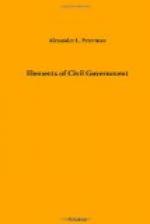There are two forms of ballots: the blanket ballot and the individual ballot. The former is arranged in some States so as to group candidates by parties, and in other States by the offices for which they are nominated. In many cases the names of candidates are alphabetically arranged, so that there can be no accusation of giving one party or candidate precedence as to position on the ticket. In a few cases, the name of the party to which the candidate belongs does not appear on the ballot at all, but only the name of the office for which he has been nominated; but in most cases the name of each party is printed either at the head of the ticket or opposite the name of each candidate, or in both places.
Where individual ballots are used, a separate ballot is printed for each party or independent ticket.
VOTING.—Special sworn clerks are engaged to distribute these ballots to voters at the polls.
The voter is allowed a limited time—say five or ten minutes—to retire into an election booth erected for the purpose, to make his choice of candidates or ballots. If the blanket ballot is in use, he does this by placing a cross opposite the name of the desired candidate or list of candidates; or by crossing out all others; or by means of pasters for the substitution of names. If individual ballots are provided, he selects the one he prefers, or corrects it to his liking by pasting upon it a single name or an entire ticket. If he prefers, he may write the names of candidates of his own nomination in place of those already printed. He, then, without communicating with any one, deposits his ballot as his vote. Only one man is allowed to enter a booth at a time, and none but the ballot clerks and the man about to deposit his ballot are allowed within the enclosure erected for the purpose.
In some States the booths are separated one from the other merely by partitions, as indicated in the cut, page 181; but in other States each booth is a separate compartment with a door, which is closed to prevent even a suspicion of any external observation.
[Illustration: (Page 181) Arrangement of polling place as required by Massachusetts law.]
In many States, assistance is rendered to the illiterate or the blind. In some cases, in order to aid those who can not read, each party adopts a device, as an eagle or a flag, which is printed on the ballot. In most States a voter who declares that he can not read, or that by some physical disability he is unable to mark his ballot, may receive the assistance of one or two of the election officers in marking it.
Every ballot must be strictly accounted for. If any person in preparing a ballot should spoil it, he may obtain others, one at a time, not exceeding three in all, provided he returns each spoiled one. All ballots thus returned are either immediately burned or else cancelled and preserved by the clerk.




